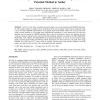Free Online Productivity Tools
i2Speak
i2Symbol
i2OCR
iTex2Img
iWeb2Print
iWeb2Shot
i2Type
iPdf2Split
iPdf2Merge
i2Bopomofo
i2Arabic
i2Style
i2Image
i2PDF
iLatex2Rtf
Sci2ools
JCC
2008
2008
The implementation of a fast and accurate QM/MM potential method in Amber
Abstract: Version 9 of the Amber simulation programs includes a new semi-empirical hybrid QM/MM functionality. This includes support for implicit solvent (generalized Born) and for periodic explicit solvent simulations using a newly developed QM/MM implementation of the particle mesh Ewald (PME) method. The code provides sufficiently accurate gradients to run constant energy QM/MM MD simulations for many nanoseconds. The link atom approach used for treating the QM/MM boundary shows improved performance, and the user interface has been rewritten to bring the format into line with classical MD simulations. Support is provided for the PM3, PDDG/PM3, PM3CARB1, AM1, MNDO, and PDDG/MNDO semi-empirical Hamiltonians as well as the self-consistent charge density functional tight binding (SCC-DFTB) method. Performance has been improved to the point where using QM/MM, for a QM system of 71 atoms within an explicitly solvated protein using periodic boundaries and PME requires less than twice the c...
Related Content
| Added | 13 Dec 2010 |
| Updated | 13 Dec 2010 |
| Type | Journal |
| Year | 2008 |
| Where | JCC |
| Authors | Ross C. Walker, Michael F. Crowley, David A. Case |
Comments (0)

